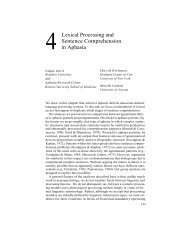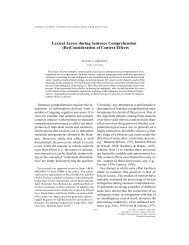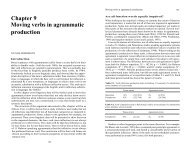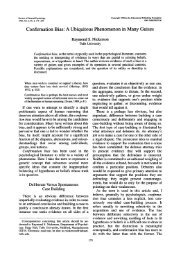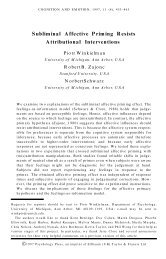Adaptation from invisible flicker - UC San Diego Department of ...
Adaptation from invisible flicker - UC San Diego Department of ...
Adaptation from invisible flicker - UC San Diego Department of ...
Create successful ePaper yourself
Turn your PDF publications into a flip-book with our unique Google optimized e-Paper software.
<strong>Adaptation</strong> <strong>from</strong> <strong>invisible</strong> <strong>flicker</strong><br />
Sherif Shady, Donald I. A. MacLeod*, and Heidi S. Fisher<br />
<strong>Department</strong> <strong>of</strong> Psychology, University <strong>of</strong> California at <strong>San</strong> <strong>Diego</strong>, 9500 Gilman Drive, MC 0109, La Jolla, CA 92037<br />
Edited by Dale Purves, Duke University Medical Center, Durham, NC, and approved January 27, 2004 (received for review June 6, 2003)<br />
Human ability to resolve temporal variation, or <strong>flicker</strong>, in the<br />
luminance (brightness) or chromaticity (color) <strong>of</strong> an image declines<br />
with increasing frequency and is limited, within the central visual<br />
field, to a critical <strong>flicker</strong> frequency <strong>of</strong> 50 and 25 Hz, respectively.<br />
Much remains unknown about the neural filtering that underlies<br />
this frequency-dependent attenuation <strong>of</strong> <strong>flicker</strong> sensitivity, most<br />
notably the number <strong>of</strong> filtering stages involved and their neural<br />
loci. Here we use the process <strong>of</strong> <strong>flicker</strong> adaptation, by which an<br />
observer’s <strong>flicker</strong> sensitivity is attenuated after prolonged exposure<br />
to <strong>flicker</strong>ing lights, as a functional landmark. We show that<br />
<strong>flicker</strong> adaptation is more sensitive to high temporal frequencies<br />
than is conscious perception and that prolonged exposure to<br />
<strong>invisible</strong> <strong>flicker</strong> <strong>of</strong> either luminance or chromaticity, at frequencies<br />
above the respective critical <strong>flicker</strong> frequency, can compromise our<br />
visual sensitivity. This suggests that multiple filtering stages,<br />
distributed across retinal and cortical loci that straddle the locus for<br />
<strong>flicker</strong> adaptation, are involved in the neural filtering <strong>of</strong> high<br />
temporal frequencies by the human visual system.<br />
The ability <strong>of</strong> the human visual system to resolve temporal<br />
modulation, or <strong>flicker</strong>, in the luminance or chromaticity <strong>of</strong><br />
the light incident onto the retina (the light-sensitive neural<br />
structure at the back <strong>of</strong> the eye) is limited. Within the central<br />
retina, where spatial resolution is optimal, the temporal resolution<br />
<strong>of</strong> a typical observer is limited to a critical <strong>flicker</strong> frequency<br />
(CFF) <strong>of</strong> 50 and 25 Hz for luminance and chromatic <strong>flicker</strong>,<br />
respectively; higher-frequency <strong>flicker</strong> is <strong>invisible</strong> (1–4). Below<br />
the CFF, our <strong>flicker</strong> sensitivity is strongly frequency-dependent.<br />
The modulation transfer function (MTF) for human <strong>flicker</strong><br />
perception, which traces modulation sensitivity as a function <strong>of</strong><br />
<strong>flicker</strong> frequency, peaks around 8 Hz (4 Hz for chromatic<br />
<strong>flicker</strong>) and falls precipitously, by 100-fold, with increasing<br />
<strong>flicker</strong> frequency, out to the resolution limit (1–4). The neural<br />
processing that mediates this sharply low-pass nature <strong>of</strong> the MTF<br />
for <strong>flicker</strong> perception remains little understood (5–9). Specifically,<br />
the questions <strong>of</strong> what the number and anatomical loci <strong>of</strong><br />
the neural filtering stages involved are remain open.<br />
Here we pursue these questions through an experimental<br />
design that exploits, as a functional landmark, the known process<br />
<strong>of</strong> <strong>flicker</strong> adaptation, by which <strong>flicker</strong> sensitivity <strong>of</strong> an observer<br />
is attenuated after prolonged exposure to <strong>flicker</strong>ing lights (10–<br />
22). The attenuation <strong>of</strong> human <strong>flicker</strong> sensitivity, consequent to<br />
adaptation, is evident in both behavioral (10–22) and neural (9,<br />
23, 24) response measures, but its frequency dependence has<br />
never been assessed systematically. Here we measure the reduction<br />
in <strong>flicker</strong> sensitivity after prolonged exposure, or adaptation,<br />
to both luminance and chromatic <strong>flicker</strong> across a wide range<br />
<strong>of</strong> frequencies. From these measurements, we derive the MTF<br />
for <strong>flicker</strong> adaptation and compare it with that for <strong>flicker</strong><br />
perception. The comparison allows us to reach conclusions<br />
regarding the number and neural loci <strong>of</strong> temporal filtering stages<br />
in the human visual system by using the neural locus <strong>of</strong> <strong>flicker</strong><br />
adaptation as a reference.<br />
Methods<br />
Stimulation. In all experiments, the stimulus was a small, spatially<br />
uniform spot subtending 3° <strong>of</strong> visual angle at the retina and<br />
presented to the central retina (fovea), with the image <strong>of</strong> the<br />
source light focused in the plane <strong>of</strong> the pupil (in ‘‘Maxwellian<br />
view’’). The light sources were red ( peak 632 nm) and green<br />
( peak 532 nm) light-emitting diodes. Stimulus control was via<br />
a 12-bit digital-to-analog converter (At-AO-610, National Instruments,<br />
Austin, TX), with a 1-kHz sampling resolution, in an<br />
IBM-compatible personal computer. For luminance <strong>flicker</strong>, only<br />
the red light source was used; modulation was defined as the<br />
proportional variation in stimulus luminance above and below<br />
the time-average level. Chromatic <strong>flicker</strong> was produced through<br />
equal, but counterphase modulation <strong>of</strong> spatially superimposed,<br />
isoluminant (see below) red and green sources. Modulation for<br />
chromatic <strong>flicker</strong> was defined as the proportional luminance<br />
variation <strong>of</strong> the individual chromatic (redgreen) components.<br />
The time-average luminance was maintained at 2,000 Troland<br />
(Td) throughout the experimental session and across all experiments.<br />
Depending on the phase <strong>of</strong> the experiment (see below for<br />
details), the stimulus was either steady at a luminance <strong>of</strong> 2,000<br />
Td or <strong>flicker</strong>ed symmetrically above and below that time-average<br />
level.<br />
Flicker <strong>Adaptation</strong>. For a period <strong>of</strong> 2 min, the stimulus <strong>flicker</strong>ed<br />
in luminance or chromaticity (but not both) at each <strong>of</strong> a range<br />
<strong>of</strong> frequencies (2–60 Hz) and modulation levels (10–100%).<br />
After this initial exposure to the adapting <strong>flicker</strong> at a given<br />
frequency and modulation level, the modulation threshold (the<br />
minimum modulation required for <strong>flicker</strong> detection) was determined<br />
for either a 10- or 30-Hz test <strong>flicker</strong>; test frequency was<br />
selected to ensure that both adaptation and detection were<br />
mediated by a single temporal channel (25, 26). To maintain the<br />
observers’ level <strong>of</strong> <strong>flicker</strong> adaptation throughout the experiment,<br />
test presentations were interleaved with repeated 3-s presentations<br />
<strong>of</strong> the adapting <strong>flicker</strong> (Fig. 1). Results <strong>of</strong> this experiment<br />
were used to derive the MTF for <strong>flicker</strong> adaptation (see Results).<br />
Flicker Perception. The MTF for <strong>flicker</strong> perception was obtained<br />
directly by measuring the modulation thresholds for a range <strong>of</strong><br />
test frequencies (2–50 Hz), presented upon a steady field, with<br />
no prior <strong>flicker</strong> exposure. The stimuli and experiment design<br />
were the same as in the <strong>flicker</strong>-adaptation experiment (see above<br />
and Fig. 1) but with two critical modifications. First, during the<br />
initial 2-min adaptation period, instead <strong>of</strong> <strong>flicker</strong>, observers<br />
viewed a steady light, with luminance set equal to the timeaverage<br />
luminance (2,000 Td) <strong>of</strong> the <strong>flicker</strong> presented in the<br />
adaptation experiment. Second, the brief <strong>flicker</strong> presentations<br />
interleaved between test presentations in the adaptation experiment<br />
were replaced with presentations <strong>of</strong> steady light (at 2,000<br />
Td). It is well known that the slope <strong>of</strong> the human MTF, our<br />
primary focus in this work, varies considerably with time-average<br />
luminance (1, 4). Maintaining the same time-average luminance<br />
across both the <strong>flicker</strong>-detection and <strong>flicker</strong>-adaptation experiments<br />
was thus a critical control.<br />
Flicker Photometry. The point <strong>of</strong> red-green isoluminance (the<br />
ratio <strong>of</strong> physical intensities at which a red and a green light are<br />
This paper was submitted directly (Track II) to the PNAS <strong>of</strong>fice.<br />
Abbreviations: CFF, critical <strong>flicker</strong> frequency; MTF, modulation transfer function; Td,<br />
Troland.<br />
*To whom correspondence should be addressed. E-mail: dmacleod@ucsd.edu.<br />
© 2004 by The National Academy <strong>of</strong> Sciences <strong>of</strong> the USA<br />
5170–5173 PNAS April 6, 2004 vol. 101 no. 14 www.pnas.orgcgidoi10.1073pnas.0303452101
Fig. 1. Stimulus pr<strong>of</strong>ile. For each condition (a given adapting frequency and<br />
modulation), 2 min <strong>of</strong> preadaptation were followed by interleaved presentations<br />
<strong>of</strong> the test (duration <strong>of</strong> 1 s) and adapting (duration <strong>of</strong> 3 s) <strong>flicker</strong>. Both<br />
the adapting and test <strong>flicker</strong> were presented within a temporal window<br />
defined by half-cosine edges (dashed curves) in order to avoid high-frequency<br />
artifacts at <strong>flicker</strong> onset and <strong>of</strong>fset.<br />
<strong>of</strong> equal luminance) depends on the spectral composition <strong>of</strong> the<br />
light sources as well as on the spectral sensitivities <strong>of</strong> the<br />
individual observers. Therefore, to produce purely chromatic<br />
<strong>flicker</strong>, the red-green isoluminant point was determined experimentally<br />
by using the technique <strong>of</strong> <strong>flicker</strong> photometry. In<br />
particular, observers viewed the same 3° spot (as described<br />
above), within which the spatially superimposed red and green<br />
lights were counterphase-modulated at a frequency <strong>of</strong> 30 Hz. At<br />
this frequency (above the chromatic CFF but below the luminance<br />
CFF), the <strong>flicker</strong> was too fast for observers to track the<br />
alternation in chromaticity, and any appearance <strong>of</strong> <strong>flicker</strong> could<br />
be attributed entirely to residual luminance perturbations. Thus,<br />
with the red modulation fixed, the isoluminance point for each<br />
observer was determined by asking the observer to adjust the<br />
green modulation to eliminate the appearance <strong>of</strong> <strong>flicker</strong>.<br />
Data Acquisition. Modulation thresholds for test <strong>flicker</strong> detection<br />
were determined by using an adaptive, yes–no staircase and a<br />
50% threshold criterion. Each staircase consisted <strong>of</strong> 30 trials.<br />
Within each trial, the 1-s test presentation was demarcated by<br />
two audible tones; after the second tone, the observer indicated<br />
whether the spot appeared to <strong>flicker</strong> during the test interval.<br />
Modulation thresholds were estimated with a 95% confidence<br />
interval <strong>of</strong> 0.1 log unit. For chromatic <strong>flicker</strong>, the red and green<br />
modulations were always equal. A two-alternative forced-choice<br />
procedure was not used because <strong>of</strong> practical limitations. However,<br />
our goal was to compare the relative positions <strong>of</strong> the MTFs<br />
for perception and adaptation (see Results); a two-alternative<br />
forced-choice procedure would have <strong>of</strong>fered no advantages,<br />
because it would have led to proportionately lower threshold<br />
estimates in both cases, leaving the relative positions (and slopes)<br />
<strong>of</strong> the two functions unchanged.<br />
Results<br />
Luminance Flicker <strong>Adaptation</strong>. Fig. 2 A and B shows, for each <strong>of</strong> two<br />
observers, modulation thresholds for the test <strong>flicker</strong>, plotted as<br />
a function <strong>of</strong> the modulation <strong>of</strong> the adapting <strong>flicker</strong>; each curve<br />
traces that function for a different adapting frequency, as<br />
labeled. Test modulation thresholds were largest (modulation<br />
sensitivity was minimal) after adaptation to frequencies in the<br />
10- to 20-Hz range, with higher adapting frequencies, out to 60<br />
Hz, producing progressively lower test thresholds (Fig. 2 A and<br />
B). Scaling the curves relating test threshold to adapting modulation<br />
along the horizontal (modulation) axis by a single<br />
multiplicative factor for each frequency brought the curves into<br />
near-perfect register (Fig. 2 C and D). This confirmed that the<br />
effect <strong>of</strong> adaptation on luminance <strong>flicker</strong> sensitivity followed a<br />
single function <strong>of</strong> the adapting <strong>flicker</strong> modulation, scaled by the<br />
Fig. 2. Data analysis (luminance <strong>flicker</strong>). (A and B) For each <strong>of</strong> two observers, test modulation threshold, expressed as a multiple <strong>of</strong> the unadapted threshold<br />
(without prior <strong>flicker</strong> exposure), is plotted vs. modulation <strong>of</strong> the adapting <strong>flicker</strong>; adapting frequency is the curve parameter. Symbols and error bars are the<br />
average across four to eight independent measurements 1SE(C and D). The curves <strong>from</strong> A and B are shown scaled along the horizontal (modulation) axis to<br />
bring all curves into register.<br />
PSYCHOLOGY<br />
Shady et al. PNAS April 6, 2004 vol. 101 no. 14 5171
Fig. 3. Luminance MTF. The MTF for luminance <strong>flicker</strong> adaptation (open squares), derived by plotting the modulation scaling factor (<strong>from</strong> Fig. 2 C and D) vs.<br />
adapting frequency, and for the conscious perception <strong>of</strong> luminance <strong>flicker</strong> (filled circles), derived by plotting the reciprocal <strong>of</strong> the unadapted modulation<br />
threshold vs. test frequency. Both functions are shown normalized to the value at 10 Hz. Each graph shows the data <strong>from</strong> one observer. Symbols and error bars<br />
represent the average <strong>of</strong> four to eight independent measurements 1 SE. The vertical line in each graph marks the CFF value; higher frequencies (hatched<br />
regions) were <strong>invisible</strong> to the observers.<br />
effectiveness <strong>of</strong> the adapting frequency. The scaling factors used<br />
in Fig. 2 C and D were thus directly proportional to modulation<br />
sensitivity as a function <strong>of</strong> adapting frequency and could be used<br />
to plot the MTF at the neural site for luminance <strong>flicker</strong><br />
adaptation (see below).<br />
Chromatic Flicker <strong>Adaptation</strong>. The data for chromatic <strong>flicker</strong> (not<br />
shown) followed a very similar pattern as for luminance <strong>flicker</strong>,<br />
but, given the lower perceptual limit for chromatic <strong>flicker</strong> (1),<br />
spanned a more limited frequency range. Test modulation<br />
thresholds were largest after adaptation to a 4-Hz <strong>flicker</strong>, with<br />
higher adapting frequencies, out to 30 Hz, producing progressively<br />
lower test thresholds. A simple multiplicative scaling <strong>of</strong> the<br />
curves relating test threshold to adapting modulation along the<br />
horizontal (modulation) axis was sufficient, as it was for the<br />
luminance <strong>flicker</strong> data, to bring all curves into register. These<br />
scaling factors, plotted as a function <strong>of</strong> adapting frequency, thus<br />
were used to trace the MTF at the neural site for chromatic<br />
<strong>flicker</strong> adaptation.<br />
The MTF. Figs. 3 and 4 show the MTF for <strong>flicker</strong> adaptation (open<br />
squares) and <strong>flicker</strong> perception (filled circles) for luminance and<br />
chromatic <strong>flicker</strong>, respectively. Flicker adaptation proved to be<br />
much more sensitive to high temporal frequencies than was<br />
conscious perception. For both luminance and chromatic <strong>flicker</strong>,<br />
the MTF for adaptation traced a notably shallower slope than<br />
that for perception.<br />
At the CFF for luminance <strong>flicker</strong>, the normalized modulation<br />
sensitivity for <strong>flicker</strong> adaptation was 10 times (1 log unit) greater<br />
than that for conscious perception (Fig. 3). Additionally, the<br />
adaptation MTF extended into the <strong>invisible</strong> range (hatched<br />
region), out to frequencies 20% above the luminance CFF (Fig.<br />
3). It is worth noting that despite eye movements, which under<br />
certain conditions can render visible <strong>flicker</strong> that would be<br />
<strong>invisible</strong> otherwise (or, indeed, lead to the perception <strong>of</strong> <strong>flicker</strong><br />
when none at all is physically present), observers reported that,<br />
whenever the adapting <strong>flicker</strong> frequency was above the independently<br />
measured CFF, the <strong>flicker</strong> remained <strong>invisible</strong><br />
throughout the period <strong>of</strong> exposure.<br />
Fig. 4. Chromatic MTF. Same as described for Fig. 3 but for chromatic <strong>flicker</strong>. The MTFs for adaptation (open squares) and perception (filled circles) are shown<br />
normalized to the value at 4 Hz. Each graph shows the data <strong>from</strong> one observer. Symbols and error bars represent the average <strong>of</strong> four to eight independent<br />
measurements 1 SE. The vertical line in each graph marks the CFF value; higher frequencies (hatched regions) were <strong>invisible</strong> to the observers.<br />
5172 www.pnas.orgcgidoi10.1073pnas.0303452101 Shady et al.
The same held true for chromatic <strong>flicker</strong> (Fig. 4), for which the<br />
divergence between the MTF for adaptation and perception was<br />
even more striking. At the chromatic CFF, normalized modulation<br />
sensitivity was 20–30 times (1.3–1.5 log unit) greater for<br />
adaptation than for conscious perception, and the adaptation<br />
MTF extended well into the <strong>invisible</strong> range, out to frequencies<br />
50% above the chromatic CFF.<br />
Discussion<br />
The results <strong>of</strong> Figs. 3 and 4 show that ambient <strong>flicker</strong> at<br />
imperceptibly high frequencies can penetrate to the neural site<br />
for <strong>flicker</strong> adaptation, which is presumed to be in primary visual<br />
cortex (23). Indeed, earlier physiological studies have demonstrated<br />
activity in human visual cortex in response to imperceptibly<br />
high <strong>flicker</strong> frequencies (5, 6), but these studies suggested<br />
no impact on perception as a result <strong>of</strong> this cortical activity. Our<br />
present findings show a clear, deleterious impact <strong>of</strong> this visuocortical<br />
response, as elicited by <strong>invisible</strong> <strong>flicker</strong>, on our ability to<br />
see subsequent perturbations in luminance or chromaticity.<br />
The key implication <strong>of</strong> our findings is that the substantial<br />
neural attenuation <strong>of</strong> high temporal frequencies by the human<br />
visual system is accomplished through a series <strong>of</strong> filtering stages,<br />
distributed across multiple retinal and cortical loci, with at least<br />
one filtering stage peripheral and one central to the neural locus<br />
for <strong>flicker</strong> adaptation. This runs counter to the long-held belief<br />
in an early (likely retinal), single-stage temporal filter.<br />
Our findings also have an interesting potential implication on<br />
the applied front for the design and use <strong>of</strong> computer displays,<br />
now in ubiquitous use by the general population. The use <strong>of</strong><br />
refresh rates at frequencies as low as 60 Hz has long been<br />
considered adequate for use in these displays, because that<br />
frequency falls outside the visible frequency range <strong>of</strong> most<br />
observers. Our findings, however, suggest that an observer’s<br />
visual sensitivity can be compromised by prolonged exposure to<br />
the image <strong>flicker</strong> (refresh rate) on these displays even when that<br />
<strong>flicker</strong> is <strong>invisible</strong> and that a rather sizeable safety margin above<br />
the perceptual limit is advisable.<br />
This work was supported by National Institutes <strong>of</strong> Health Grant EY-<br />
01711.<br />
1. de Lange, H. (1958) J. Opt. Soc. Am. 48, 771–783.<br />
2. Brown, J. L. (1965) in Vision and Visual Perception, ed. Graham, C. H. (Wiley,<br />
New York).<br />
3. Matin, L. (1968) J. Opt. Soc. Am. 58, 404–415.<br />
4. Kelly, D. H. (1971) J. Opt. Soc. Am. 61, 537–546.<br />
5. Van der Tweel, L. H. (1963) Doc. Ophthalmol. 18, 287–304.<br />
6. Regan, D. (1968) Electroencephalogr. Clin. Neurophysiol. 25, 231–237.<br />
7. Regan, D. & Beverley, K. I. (1973) Perception 2, 61–65.<br />
8. Burns, S. A., Elsner, A. E. & Kreitz, M. R. (1992) Optom. Vis. Sci. 69, 95–105.<br />
9. Wu, S., Burns, S. A. & Elsner, A. E. (1995) Vision Res. 35, 2943–2953.<br />
10. Granit, R. A. & von Ammon, W. (1930) Am. J. Physiol. 95, 229–241.<br />
11. Ginsburg, N. (1966) Am. J. Psychol. 79, 296–300.<br />
12. Pantle, A. (1971) Vision Res. 11, 943–952.<br />
13. Smith, R. A., Jr. (1971) J. Physiol. (London) 216, 531–552.<br />
14. Kelly, D. H. (1972) Vision Res. 12, 89–101.<br />
15. Krauskopf, J. (1976) in Information Processes in Visual System: Proceedings <strong>of</strong><br />
the IVth Symposium on Sensory System Physiology, ed. Gilezer, V.D. (Leningrad,<br />
Russia), p. 234.<br />
16. Jameson, D., Hurvich, L. M. & Varner, F. D. (1979) Proc. Natl. Acad. Sci USA.<br />
76, 3034–3038.<br />
17. Krauskopf, J., Williams, D. R. & Heeley, D. W. (1982) Vision Res. 22, 1123–1131.<br />
18. Benzschawel, T. & Guth, S. L. (1982) Vision Res. 22, 69–76.<br />
19. Lorenceau, J. (1987) Vision Res. 27, 2185–2191.<br />
20. Schieting, S. & Spillmann, L. (1987) Vision Res. 27, 277–284.<br />
21. Webster, M. A. & Mollon, J. D. (1994) Vision Res. 34, 1993–2020.<br />
22. Anstis, S. (1996) Vision Res. 36, 3479–3485.<br />
23. Movshon, J. A. & Lennie, P. (1979) Nature 278, 850–852.<br />
24. Chander, D. & Chichilnisky, E. J. (2001) J. Neurosci. 21, 9904–9916.<br />
25. Mandler, M. B. & Makous, W. (1984) Vision Res. 24, 1881–1887.<br />
26. Hammett, S. T. & Smith, A. T. (1992) Vision Res. 32, 285–291.<br />
PSYCHOLOGY<br />
Shady et al. PNAS April 6, 2004 vol. 101 no. 14 5173



